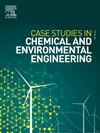Optimization of liquid fuel production from co-pyrolysis of oil palm fronds and expanded polystyrene using response surface methodology
Q1 Environmental Science
Case Studies in Chemical and Environmental Engineering
Pub Date : 2024-12-18
DOI:10.1016/j.cscee.2024.101074
引用次数: 0
Abstract
The transformation of plastic and biomass waste into fuel promotes sustainable energy alternatives and efficient waste management. In this study, liquid fuel production from co-pyrolysis of oil palm fronds (PF) and expanded polystyrene (EPS) was experimentally investigated in a fixed-bed reactor. The effect of process temperature (T, 300–500 °C), and PF-to-EPS ratio (R, 0.1 to 9) on pyrolysis oil yield (YPO) and PAH's composition (PAHC) was studied using Response Surface Methodology (RSM) based on Central Composite Design (CCD). PF-to-EPS ratio (R) was found to be the most significant process parameter for determining the YPO, while T was the most influential process parameter affecting PAHC. The maximum pyrolysis oil yield of 80.11 wt% and minimum PAH composition of 20.63 % area was obtained at an optimum T of 395 °C and 0.1 R. The pyrolysis oil also contained benzene with a concentration below the established standards. The pyrolysis oil produced under optimum conditions had a calorific value of 41.56 MJ/kg, kinematic viscosity at 40 °C of 0.85 mm2/s, density at 15 °C of 0.93 g/cm3, water content of 0.24 wt%, acidity of 3.46 mg KOH/g, and a flash point of 26.05 °C. Pyrolysis oil can potentially improve gasoline's octane rating because of its high aromatic compound content.

利用响应面法优化油棕叶与膨胀聚苯乙烯共热解生产液体燃料
将塑料和生物质废物转化为燃料促进了可持续的能源替代品和有效的废物管理。本研究在固定床反应器中对油棕叶(PF)和膨胀聚苯乙烯(EPS)共热解生产液体燃料进行了实验研究。采用基于中心复合设计(CCD)的响应面法(RSM)研究了工艺温度(T, 300 ~ 500℃)和pf / eps比(R, 0.1 ~ 9)对热解油收率(YPO)和多环芳烃组分(PAHC)的影响。发现pf - eps比(R)是决定YPO最显著的工艺参数,而T是影响PAHC最显著的工艺参数。在温度为395℃,温度为0.1 r的条件下,热解油的最大收率为80.11 wt%, PAH的最小组成面积为20.63%。在最佳条件下制备的热解油热值为41.56 MJ/kg, 40℃时运动粘度为0.85 mm2/s, 15℃时密度为0.93 g/cm3,含水量为0.24 wt%,酸度为3.46 mg KOH/g,闪点为26.05℃。热解油的芳香族化合物含量高,有可能提高汽油的辛烷值。
本文章由计算机程序翻译,如有差异,请以英文原文为准。
求助全文
约1分钟内获得全文
求助全文
来源期刊

Case Studies in Chemical and Environmental Engineering
Engineering-Engineering (miscellaneous)
CiteScore
9.20
自引率
0.00%
发文量
103
审稿时长
40 days
 求助内容:
求助内容: 应助结果提醒方式:
应助结果提醒方式:


